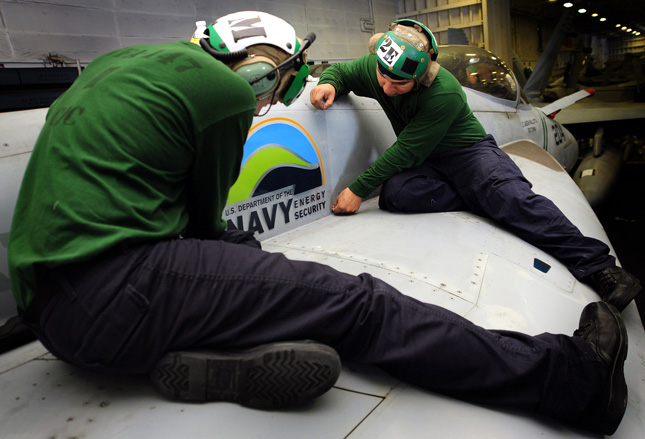-
Can the Military Help Change the Way We Think About Energy?
January 27, 2015 By Schuyler Null
How to stop climate change while expanding energy production is one of the biggest challenges in global development. Doing so requires all kinds of improvements in efficiency – from reducing the amount of electricity lost in transmission to better motors and lightbulbs. But, as demonstrated by recent efforts in the Pentagon, changes to how people work may be the lowest hanging fruit.
Changes to how people work may be the lowest hanging fruitIn the first of a three-part series in The Washington Post, Chris Mooney talks about a collaboration between Wilson Center Public Policy Scholar Ruth Greenspan Bell and Columbia University psychologist Elke Weber with the U.S. Navy and Marine Corps to implement behavioral changes on a broad scale to reduce energy use.
Behavioral changes could lead to things like reducing idling time for heavy vehicles, changing how mid-air refueling works, and reducing the number of engines used by cruising ships, writes Mooney:
In 2009, Secretary of the Navy Ray Mabus mandated that by the year 2020, his department (which includes the Marine Corps) would get half of its total energy from alternative sources. Now, his assistant secretary for Energy, Installations, and Environment, Dennis McGinn – who recently returned to the Navy after heading the American Council on Renewable Energy – has partnered with two behavioral science experts, Columbia University psychologist Elke Weber and the Woodrow Wilson Center’s Ruth Greenspan Bell, to find behavioral changes that can lead to big energy savings.
The goal, says McGinn, is “taking behavior research that has been shown to be effective in understanding organizational and individual behavior, and applying it to a new problem set: How can the Department of the Navy change its culture and approach to energy?”
The savings could be vast: the Department of the Navy spends some $5 billion annually on fuel. That’s 1.25 billion barrels, and transporting it around presents any number of challenges, from holding up operations to presenting vulnerabilities. So any reduction is desirable, from a tactical standpoint.
So what are the behavioral possibilities? According to Rear Adm. Kevin Slates, who heads the Navy’s Energy and Environmental Readiness Division, many Navy ships can save energy by changing older patterns for how they are operated. Often these ships, he explains, have two large propellers and two to four engines – and they don’t all have to be engaged in many circumstances.
“At lower speeds…I can shut down two or three of those engines, disengage one of the propellers so it’s not dragging and it’s just spinning, [and] then you don’t have to drag through the water. It’s going obviously through the water more efficiently,” says Slates.
Slates says he is also looking at changes to how much Navy planes idle before takeoff, and the process by which planes refuel in midair. One new practice here is called “smart tanking,” which can provide a 65 percent reduction in fuel use by cutting how long tankers remain in the air. With less air time, the tankers don’t have to bring up as much fuel with them, which in turn means they experience less aerial drag.
“When the Department of the Navy started this energy focus five years ago, I think some people had the perception that it’s really all about technology,” says Slates. “But I don’t personally think that’s the biggest potential piece. I think the biggest potential piece is behavior.”
Experience on the battlefields of Iraq and Afghanistan demonstrated how reducing energy consumption saves American lives and reduces injuries – every convoy of fuel was an opportunity for attack. The use of behavioral economics to effect changes in both individual and organizational behavior, combined with appropriate technology changes, has the potential to improve mission effectiveness and reduce casualties by increasing the range and endurance of forces in the field while reducing their supply chain.
Smart use of behavioral economics has the potential to greatly improve public and private organizational effectiveness across the board, says Bell, not just in the military.
Bell and Weber’s partnership with the Pentagon began through a network they created with a National Science Foundation grant and includes collaboration with the Department of Energy’s Federal Energy Management Program. Overall, the effort is intended to test ideas that could be applied to business, government, and public policy.
The full article is worth a read.
Sources: Defense Science Board, U.S. Department of Defense, The Washington Post.
Photo Credit: Jonathan A. Colon/U.S. Navy.
 A Publication of the Stimson Center.
A Publication of the Stimson Center.



